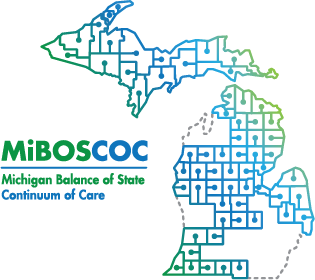The Michigan Balance of State Continuum of Care
Need shelter or housing assistance?
|
The Michigan Balance of State Continuum of Care (MIBOSCOC) represents 61 of Michigan’s 83 counties to the US Department of Housing and Urban Development as a recognized Continuum of Care (CoC) body. These are 61 of the most rural counties across the State of Michigan, stretching from the western mountains of the Upper Peninsula, across the Thumb, and to the Indiana border. Our goal as a CoC is to work together to end homelessness by sharing best practices and combining efforts to secure more housing resources.
The MIBOSCOC conducts most of its work through committees, some are organized around a goal (improving system performance), some around special population groups (youth), and some around geographic area (local planning bodies). Each of these committees strengthens the work of the whole, ensuring that homelessness will be rare, brief, and non-recurring for many more people. |
Mission
MIBOSCOC promotes the prevention and ending of homelessness by developing and maintaining a system to coordinate federal and statewide resources and services for people experiencing homelessness in the Michigan Balance of State geographic area.
MIBOSCOC promotes the prevention and ending of homelessness by developing and maintaining a system to coordinate federal and statewide resources and services for people experiencing homelessness in the Michigan Balance of State geographic area.
Vision
No one is homeless – everyone has a safe, stable place to call home.
No one is homeless – everyone has a safe, stable place to call home.
Purpose
MIBOSCOC coordinates the jurisdiction’s policies, strategies, and activities toward the prevention of homelessness and ending homelessness.
MIBOSCOC coordinates the jurisdiction’s policies, strategies, and activities toward the prevention of homelessness and ending homelessness.
Our Priorities Are To:
Prioritize vulnerable populations
Homelessness has significant detrimental effects on everyone, yet there are some whose health and safety are placed at even greater risk for harm without a safe and stable place to call home. These groups include, but are not limited to: children, youth, chronically homeless, individuals fleeing from domestic violence situations, veterans and people with disabilities. Strategies to identify and assist the most vulnerable groups will be prioritized.
Promote justice for all vulnerable populations
To eliminate the disproportionate rates of homelessness among many communities of vulnerable populations, we will adopt strategies to achieve equity in both access and outcomes in all areas of housing and services. These strategies will include culturally specific services, using a racially equitable lens across all program investments and dedicated funds to eliminate disparities.
Use data-driven assessment and accountability
To best utilize our resources, we must understand the outcomes of our investments, evaluate progress and demonstrate accountability. We will continue to improve and expand our community-wide data system so funders and providers can efficiently collect data, share knowledge for better client outcomes and report outcomes against the goals of the CoC.
Engage and involve the community
Policy makers and community stakeholders must understand the magnitude of the challenge, the costs if we do not meet the challenge, our strategies for ending homelessness and the importance of obtaining and allocating resources equal to our aspirations. An action plan for ending homelessness in Michigan will ensure that the specific concerns and interests of our local, regional and national stakeholders are heard and addressed.
Strengthen system capacity and increase leveraging opportunities
The longstanding solutions to prevent and end homelessness transcend multiple systems of care, foster care, education, domestic violence, community justice, health, mental health and addictions and available resources. To permanently end homelessness, we must strengthen efficiencies in our current system and better align other resources towards ending homelessness.
Homelessness has significant detrimental effects on everyone, yet there are some whose health and safety are placed at even greater risk for harm without a safe and stable place to call home. These groups include, but are not limited to: children, youth, chronically homeless, individuals fleeing from domestic violence situations, veterans and people with disabilities. Strategies to identify and assist the most vulnerable groups will be prioritized.
Promote justice for all vulnerable populations
To eliminate the disproportionate rates of homelessness among many communities of vulnerable populations, we will adopt strategies to achieve equity in both access and outcomes in all areas of housing and services. These strategies will include culturally specific services, using a racially equitable lens across all program investments and dedicated funds to eliminate disparities.
Use data-driven assessment and accountability
To best utilize our resources, we must understand the outcomes of our investments, evaluate progress and demonstrate accountability. We will continue to improve and expand our community-wide data system so funders and providers can efficiently collect data, share knowledge for better client outcomes and report outcomes against the goals of the CoC.
Engage and involve the community
Policy makers and community stakeholders must understand the magnitude of the challenge, the costs if we do not meet the challenge, our strategies for ending homelessness and the importance of obtaining and allocating resources equal to our aspirations. An action plan for ending homelessness in Michigan will ensure that the specific concerns and interests of our local, regional and national stakeholders are heard and addressed.
Strengthen system capacity and increase leveraging opportunities
The longstanding solutions to prevent and end homelessness transcend multiple systems of care, foster care, education, domestic violence, community justice, health, mental health and addictions and available resources. To permanently end homelessness, we must strengthen efficiencies in our current system and better align other resources towards ending homelessness.

